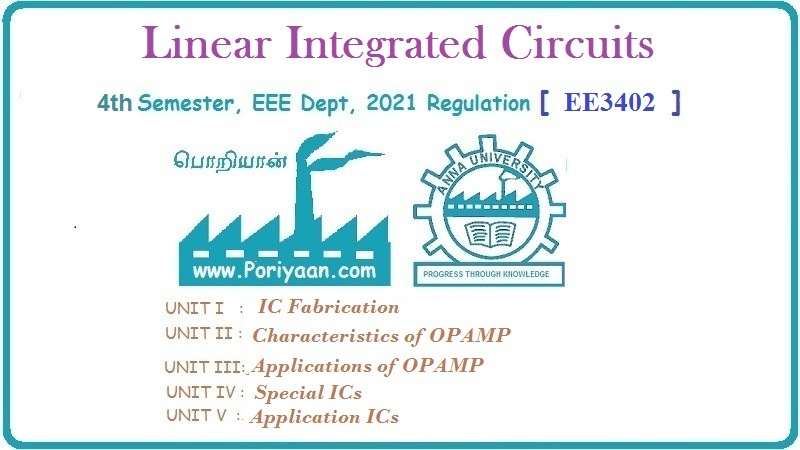Linear Integrated Circuits: Unit II: Characteristics of Op-amp
D.C. Characteristics of Op-amp
The important d.c. characteristics of op-amp are, 1. Input bias current (Ib), 2. foput offset current (Iios) 3. Input offset voltage (Vios), 4. Thermal drift
D.C. Characteristics of Op-amp
The
important d.c. characteristics of op-amp are,
1.
Input bias current (Ib),
2.
foput offset current (Iios)
3.
Input offset voltage (Vios),
4.
Thermal drift
The
input bias current, input offset current and input offset voltage are already
discussed. The effect of these parameters is to add the error to the expected
d.c. output voltage. These parameters produce output offset voltage Voos.
1. Thermal Drift
The
op-amp parameters input offset voltage Vios, input bias current Ib
and input offset current Ijos are not constants but vary with the factors :
i)
Temperature ii) Supply voltage changes and iii) Time
The
effect of change in temperature on the parameters is most severe. Let us
discuss the effect of change in temperature on these parameters.
a.
Effect on Input Offset Voltage
The
effect of change in temperature on the input offset voltage is defined by a
factor called thermal voltage drift. It is also called as input offset voltage
drift.
The
thermal voltage drift is defined as average rate of change of input offset
voltage per unit change in temperature. Mathematically it is given by,
Input
offset voltage drift = Δ Vios / Δ T … (2.14.1)
where
Δ Vios = Change in input offset voltage
Δ
T = Change in temperature
It
is expressed in µV/°C. The drift is not constant and it is not uniform over
specified operating temperature range. The value of the input offset voltage may
increase or decrease with the increasing temperature.

The
Fig. 2.14.1 shows the graph of normalized values of input offset voltage versus
temperature, for MC1741 op-amp.
The
input offset voltage is zero at room temperature of 25 °C Referring to the
graph shown in the Fig. 2.14.1, the thermal voltage drift values can be
obtained.
b.
Effect on Input Offset and Bias Currents
Similar
to the input offset voltage, input bias current and input offset current are
not constants but vary with temperature. The effect of temperature on input
bias current is defined by a factor called input bias current drift while
effect on input offset current is defined by a factor called input offset
current drift.
The
average rate of change of Normalised input bias current per unit change Iio in
temperature is called input bias current drift.
The
average rate of input offset current per unit change in temperature is called
input offset current drift.
Mathematically
these drifts are given by,
Thermal
drift in input bias current = ΔIb / ΔT ...(2.14.2)
Thermal
drift in input offset current = ΔIios
/ ΔT ...(2.14.3)
Both
the drifts are measured in nA/ °C or pA/ °C. These parameters vary randomly
with temperature i.e. they may be positive in one temperature range and
negative in another.
The
Fig. 2.14.2 (a) and 2.14.2 (b) show the graphs of normalized values of input
bias current and input offset current versus temperature, for MC1741 op-amp.
These curves are different for different types of op-amps and are generally
provided by the manufacturers.

The
input offset current is assumed to be zero at room temperature of 25 °C.
Practically
no information is available about the change in input bias current versus
temperature. Infact when compensating resistance Rcomp is used, there is no
need to consider the change in input bias current as a function of change in
temperature.
Review Question
1. List the d.c. characteristics of op-amp and define each of
them.
May-07, 08, 11, Dec.-09, 16, Marks 8
2. Explain thermal drift.
Linear Integrated Circuits: Unit II: Characteristics of Op-amp : Tag: : - D.C. Characteristics of Op-amp
Related Topics
Related Subjects
Linear Integrated Circuits
EE3402 Lic Operational Amplifiers 4th Semester EEE Dept | 2021 Regulation | 4th Semester EEE Dept 2021 Regulation
